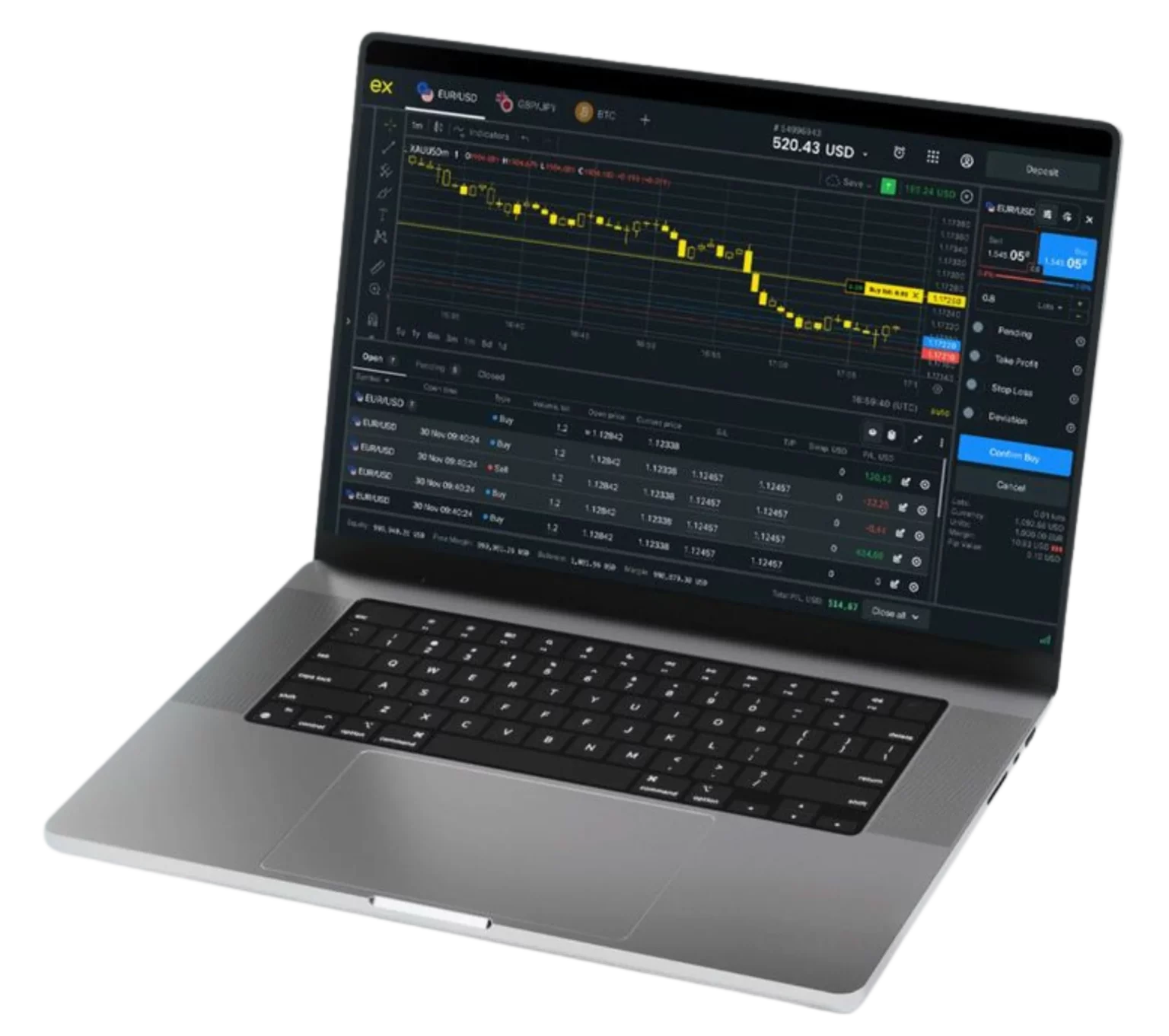- How to Get Started with the Exness Web Terminal
- Overview of the Exness Web Terminal Features
- Optimizing the Exness Web Terminal for Better Trading Performance
- Efficient Trading on the Exness Web Terminal
- Advanced Trading Strategies for Exness Web Terminal
- Advantages and Disadvantages of the Exness Web Terminal
- Exness MT4 and MT5 Web Terminals: Comprehensive Overview and Comparison
- Comparison of Exness Web Terminals with Other Trading Platforms
- Conclusion
- FAQ
The Exness Web Terminal provides a streamlined trading experience directly through your web browser, eliminating the need for software downloads or installations. This platform is perfect for traders who prefer a clean and simple interface while still having access to the essential tools for effective trading.
How to Get Started with the Exness Web Terminal
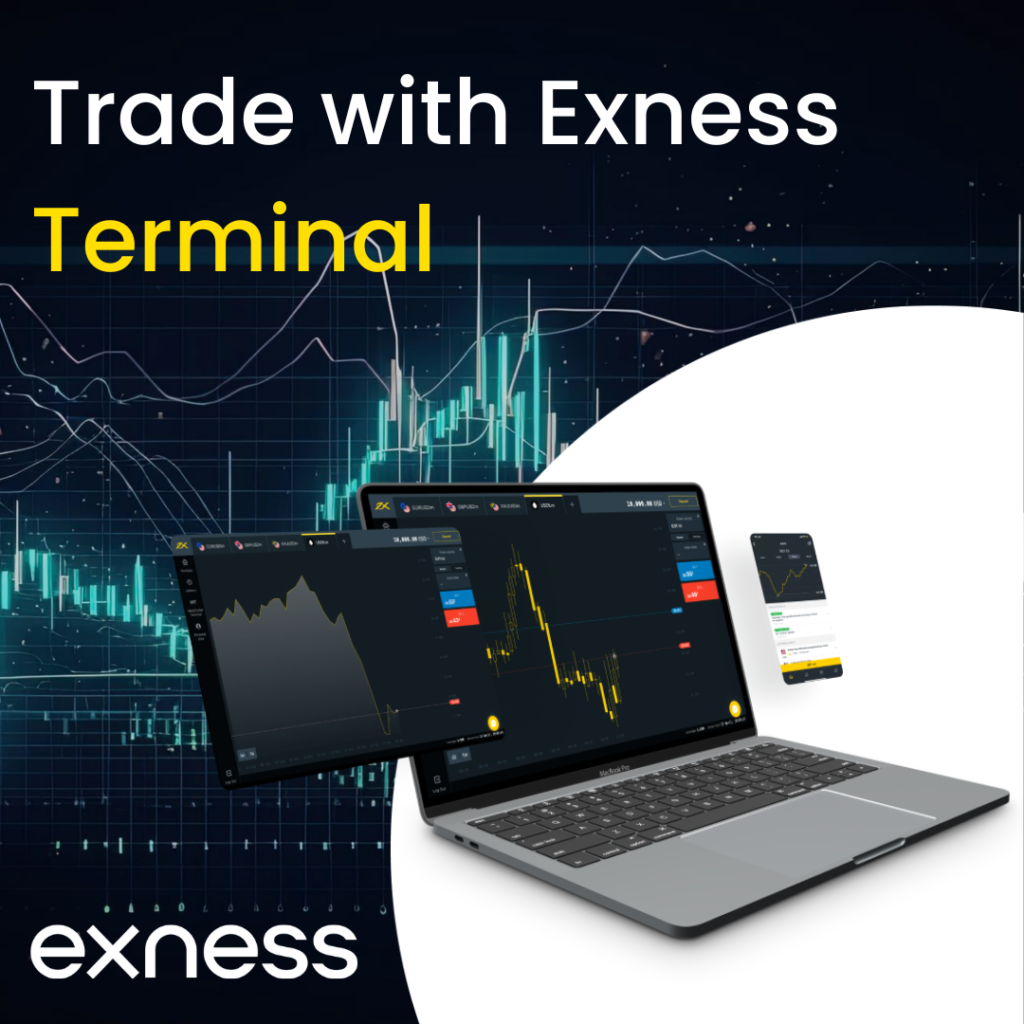
Accessing the Web Terminal:
- Head to the official Exness website.
- Go to the ‘Trading’ section and choose the Web Terminal Exness option.
Logging In:
- Visit the Exness Web Terminal login page.
- Enter your trading account credentials. If you don’t have an account yet, you can easily register for one on the Exness homepage.
Familiarizing Yourself with the Interface:
Once logged in, take some time to explore the platform. Understand the layout and where the key features are located to streamline your trading experience.
Setting Up Your Trading Environment:
Customize your trading charts and set up the tools or indicators you frequently use.
Funding Your Account:
Ensure your account has enough funds to trade. You can make deposits through your Exness Personal Area.
Placing Trades:
Use the available tools to analyze the market and place trades by selecting your instruments and setting order types. Implement risk management strategies like stop loss and take profit to manage your trades effectively.
Overview of the Exness Web Terminal Features
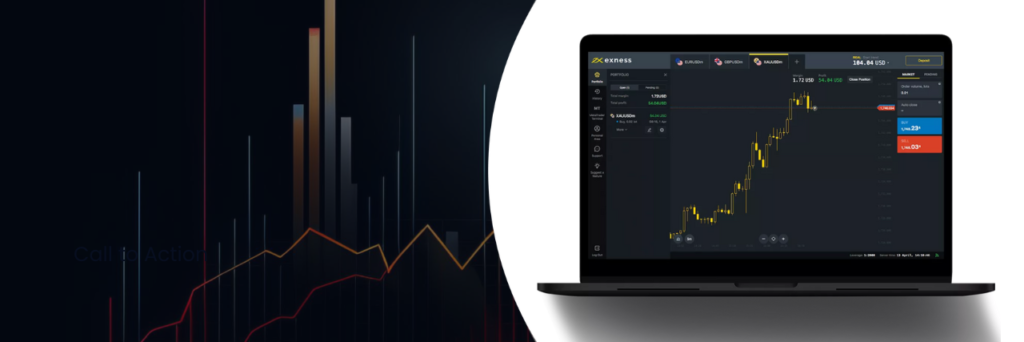
User Interface:
- Intuitive Design: The Web Terminal Exness offers a simple and easy-to-navigate interface, making it accessible to both beginners and experienced traders.
- No Downloads Required: You can access the platform directly through any web browser, ensuring flexibility and convenience.
Trading Features:
- One-Click Trading: Execute trades quickly with one-click functionality, ideal for capturing fast market movements.
- Real-Time Price Updates: Get up-to-the-minute quotes for all tradeable instruments to ensure you’re always informed of market changes.
Tools and Resources:
- Advanced Charting Tools: Use a variety of charting options and technical indicators to perform detailed market analysis.
- Integrated Economic Calendar: Stay updated on important economic events that may affect market volatility.
Security Measures:
- Secure Login: SSL encryption ensures that your login credentials and transaction data are kept safe.
- Data Privacy: Your personal and financial information is protected at all times.
Device Compatibility:
- Cross-Platform Access: The Exness Web Terminal is compatible with multiple devices, allowing you to trade from PCs, tablets, and smartphones without compromising performance.
Support:
- Comprehensive Help and Support: Traders can access support directly through the platform, ensuring you get assistance when needed.
Optimizing the Exness Web Terminal for Better Trading Performance
To get the most out of the Web Terminal Exness, it’s essential to set up the platform according to your trading needs.
1. Customizing the Interface:
- Layout Adjustments: Organize the terminal layout to ensure important features like charts and order books are in convenient positions. This will improve your workflow and accessibility.
- Chart Customization: Select your preferred chart type (candlestick, bar, line) and adjust colors and styles for clearer market analysis.
2. Integrating Technical Tools and Indicators:
- Adding Indicators: Equip your charts with popular technical indicators such as Moving Averages or MACD. You can also adjust the settings to align with your trading strategy.
- Graphical Tools: Use tools like Fibonacci retracements and trend lines to analyze price movements and find potential entry/exit points.
3. Setting Up Trading Preferences:
- Trade Configuration: Set default preferences like lot sizes, leverage, and stop loss or take profit levels. This can help speed up your trading process and improve efficiency.
- Alerts Setup: Configure alerts for key price levels or market events, so you’re always aware of significant market movements without needing to constantly monitor your trades.
Efficient Trading on the Exness Web Terminal
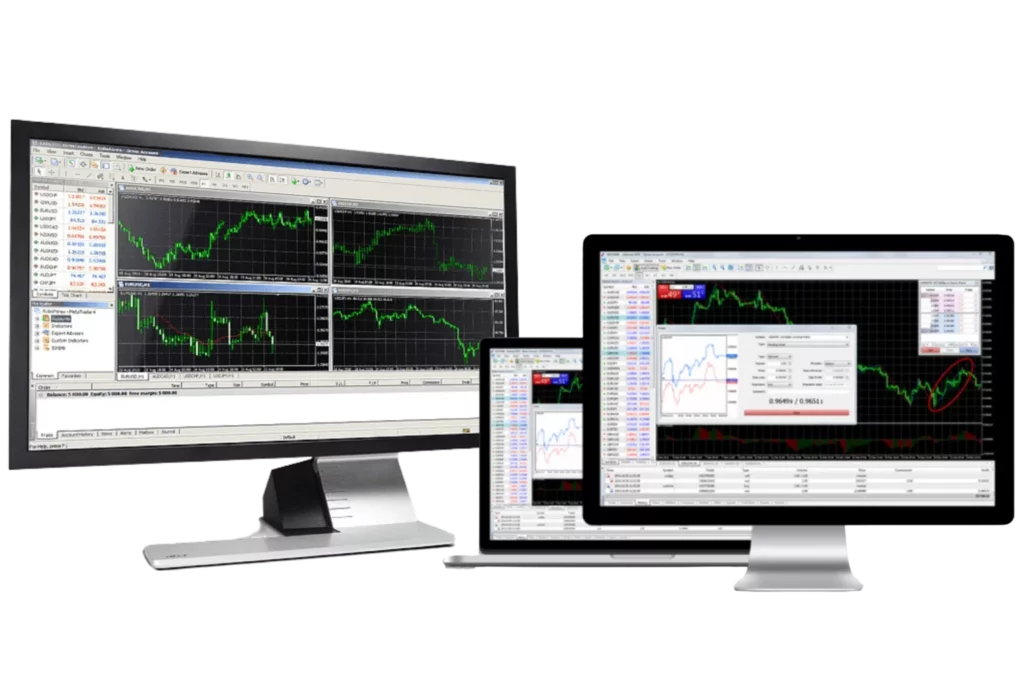
Placing a Trade:
- Select the Instrument: Choose your desired financial instrument from the Market Watch or the chart.
- Opening Orders: Click on ‘New Order’ and input your trade details such as volume and stop loss/take profit settings.
- Executing the Trade: Once everything is set, confirm by clicking ‘Buy’ or ‘Sell.’
Managing Pending Orders:
- Setting Up Pending Orders: Select a pending order type like Buy Limit or Sell Limit and set your desired price trigger.
- Order Customization: Define the volume and set additional parameters like stop loss or take profit.
- Order Activation: The trade will automatically execute when market conditions meet your preset criteria.
Modifying and Closing Orders:
- Adjusting Orders: Go to the ‘Trade’ tab, right-click the order, and select ‘Modify or Delete Order’ to update your settings.
- Closing Orders: Right-click on a trade in the ‘Trade’ tab and choose ‘Close Order’ to finalize the trade.
The Exness Web Terminal provides an intuitive and powerful platform that allows traders to execute trades with ease and efficiency. Whether you’re customizing the interface or setting up technical tools, the web terminal Exness is designed to enhance your trading strategies. By properly configuring the platform, you can maximize your trading potential, making the most of the web-based functionality from any location with internet access.
Advanced Trading Strategies for Exness Web Terminal
The Exness Web Terminal provides traders with a flexible and user-friendly web-based platform for executing trades and analyzing markets without the need for software downloads. To maximize the platform’s capabilities, it’s essential to use advanced trading strategies that leverage the full potential of its real-time data, customizable charts, and built-in tools. Below, we explore detailed strategies that can help you take your trading to the next level using the web terminal Exness.
1. Trend Following Strategy
Setup:
Trend following is a widely-used strategy that focuses on trading in the direction of the market’s long-term trend. In the Exness Web Terminal, you can use technical indicators like Moving Averages (SMA, EMA) or the MACD (Moving Average Convergence Divergence) to identify the overall market direction.
- Moving Averages (SMA or EMA): The Simple Moving Average (SMA) smooths out price data over a specific time period, making it easier to identify the market’s direction. A rising SMA suggests an uptrend, while a falling SMA points to a downtrend.
- MACD: The MACD provides more detailed trend data by comparing two moving averages. When the MACD line crosses above the signal line, it’s a bullish signal; when it crosses below, it’s bearish.
Action:
In a trending market, the goal is to trade in the direction of the trend. For an uptrend, wait for the price to pull back towards a moving average (support level) and enter a buy trade. In a downtrend, wait for the price to retrace towards resistance and then open a sell position.
Management:
Effective risk management is key to the trend-following strategy. Place stop-loss orders below support levels in an uptrend or above resistance in a downtrend to minimize potential losses in case the trend reverses. You can also use trailing stops to lock in profits as the trend progresses.
Example:
In the web terminal Exness, set your SMA to a 50-period for identifying long-term trends. If the price pulls back towards the 50-period SMA during an uptrend, consider entering a buy position, placing a stop loss below the SMA.
2. Range Trading Strategy
Setup:
Range trading involves identifying securities that are moving between a consistent high (resistance) and low (support). Tools like Bollinger Bands or the Stochastic Oscillator, available in the Exness Web Terminal, help pinpoint these ranges by highlighting overbought or oversold conditions.
- Bollinger Bands: These consist of three lines – the middle line is a moving average, and the upper and lower bands represent volatility. When the price reaches the lower band, it may be oversold, and when it reaches the upper band, it may be overbought.
- Stochastic Oscillator: This tool compares the current closing price to the price range over a specific period, helping identify potential reversals at support and resistance levels.
Action:
In range trading, you buy at support (when the price is oversold) and sell at resistance (when the price is overbought). For example, when the price hits the lower Bollinger Band and the Stochastic Oscillator signals an oversold condition, it may be a good time to buy.
Management:
Place stop-loss orders just outside the range to protect against unexpected breakouts. Additionally, set take-profit orders near the opposite boundary of the range to secure profits.
Example:
In the web terminal Exness, you might see a stock fluctuating between a support level of $100 and resistance at $120. Using Bollinger Bands, if the price hits $100 and the bands suggest oversold conditions, you could open a buy order with a stop loss at $98 and a take profit at $118.
3. Scalping Strategy
Setup:
Scalping is a short-term trading strategy that involves making numerous small trades to take advantage of tiny price movements. This strategy relies heavily on speed, precision, and real-time market data – all of which the Exness Web Terminal provides with its real-time quotes and fast execution.
- Real-Time Quotes: The ability to get immediate price updates is critical for scalping, as you need to enter and exit trades within seconds or minutes.
- Short Time Frames: Use 1-minute or 5-minute charts in the Exness Web Terminal to closely monitor price movements.
Action:
Scalpers aim to make multiple trades throughout the day, taking advantage of small price changes. The key is to enter and exit trades quickly, collecting small profits that add up over time. Look for highly liquid markets where small spreads make scalping more efficient.
Management:
Scalping requires tight stop-loss orders to minimize risk. Since trades are executed quickly, you need to cut losses immediately if the market moves against you. Quick take-profits are also important to lock in small gains before the market shifts.
Example:
In the web terminal Exness, set your chart to a 1-minute timeframe. Suppose a currency pair shows small upward ticks every few minutes. You could open a buy position at the start of an upward tick and close it a few pips higher. Repeat this process multiple times throughout the day for cumulative gains.
4. News Trading Strategy
Setup:
News trading capitalizes on significant market movements that occur following major economic releases or geopolitical events. The Exness Web Terminal comes equipped with an integrated economic calendar, which alerts you to upcoming events that can impact market volatility.
- Economic Calendar: Use the calendar to stay informed about important events, such as central bank announcements, employment reports, or political events, which often cause sharp price movements.
Action:
Before a major economic event, analyze the market sentiment and decide whether to enter a trade in anticipation of the outcome. For instance, if the market expects positive news (e.g., a strong GDP report), you may enter a long position on a currency pair before the announcement.
Management:
Price volatility during news events can lead to large price spikes, so it’s essential to use wider stop-losses to accommodate these fluctuations. Consider using limit orders to control the price at which your trade is executed.
Example:
If you know a significant interest rate decision is approaching, you could use the Exness Web Terminal’s economic calendar to time your trade. Enter a buy or sell position depending on your analysis of the expected outcome, and set a wider stop-loss to account for price volatility.
Implementing These Strategies with Exness Web Terminal
Integration with Tools:
The Exness Web Terminal offers a wide array of customizable charts, technical indicators, and drawing tools, allowing you to implement these strategies effectively. Use trendlines, Fibonacci retracements, and support/resistance levels to enhance your technical analysis.
- Technical Indicators: Tools like MACD, RSI, and Bollinger Bands can be easily added to your charts to assist in strategy execution.
- Customization: Adjust your chart layouts and indicator settings to suit your strategy and trading style.
Risk Management:
No matter which strategy you use, effective risk management is essential. Always consider your risk-reward ratio, never risk more than you can afford to lose, and use stop-loss orders to protect your capital.
- Leverage Management: Adjust your leverage according to your risk tolerance. High leverage can increase both potential gains and losses, so use it wisely.
Continuous Learning:
The market is constantly evolving, and your strategies should evolve with it. Regularly review market conditions, economic news, and performance analytics to refine your trading approach. Stay informed about changes in the global economy that could affect the markets you trade.
Advantages and Disadvantages of the Exness Web Terminal
Advantages:
- Accessibility: The Exness Web Terminal can be accessed from any device with an internet connection, offering the flexibility to trade from anywhere without downloading additional software.
- User-Friendly Interface: The intuitive design of the platform makes it easy for both beginners and experienced traders to navigate while providing access to advanced features like customizable charts and technical indicators.
- Real-Time Data: Immediate access to real-time quotes across multiple instruments ensures you’re always informed about the latest market movements.
- Integrated Tools: The platform includes a comprehensive suite of technical indicators, charting tools, and an economic calendar, allowing for thorough market analysis without leaving the terminal.
- Maintenance-Free: The web-based platform is managed and maintained by Exness, freeing you from software updates and focusing solely on trading.
Disadvantages:
- Limited Customization: While the Exness Web Terminal is equipped with many essential features, it may lack some of the advanced customization options available in downloadable platforms like MT4 or MT5.
- Resource Intensity: Being a web-based platform, the terminal may consume more system resources, which could affect performance on devices with limited processing power, especially when multiple tabs or applications are open.
Exness MT4 and MT5 Web Terminals: Comprehensive Overview and Comparison
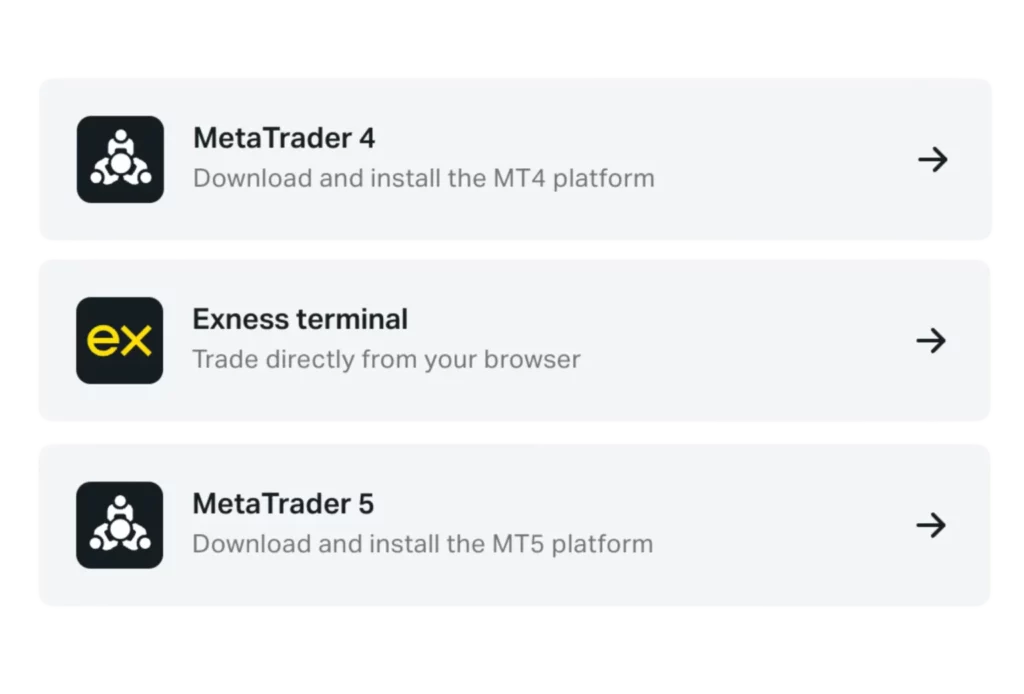
Exness provides advanced web-based trading platforms through both the MT4 and MT5 Web Terminals, delivering powerful trading functionality combined with the convenience of browser-based access. In this detailed review, we’ll explore the features of each platform, highlight their key differences, and compare them with other trading platforms to help you choose the most suitable one for your trading needs.
Exness MT4 Web Terminal
Overview
The Exness MT4 Web Terminal brings the familiar MetaTrader 4 platform directly to your browser, allowing you to trade from any device with internet access. This platform is ideal for traders who require mobility and quick access without the need for downloading or installing software.
Key Features:
- Accessibility: The MT4 web terminal Exness allows traders to access their accounts from any internet-connected device using a browser, eliminating the need for software installation.
- Full MT4 Functionality: Despite being web-based, it retains all the core features of the desktop version, including real-time price quotes, live charting, and trade execution.
- Technical Analysis Tools: Equipped with a comprehensive range of indicators and graphical tools, the MT4 web terminal supports detailed market analysis across various timeframes.
- One-Click Trading: This feature enables fast trade execution, perfect for high-frequency traders who need to respond quickly to market changes.
Exness MT5 Web Terminal
Overview
The Exness MT5 Web Terminal enhances the capabilities of MetaTrader 5 within a web-based format. Designed for traders who require more advanced functionality, this platform provides superior tools and a more comprehensive trading experience than MT4.
Key Features:
- Advanced Trading Features: The MT5 web terminal Exness includes modern order types (like Buy Stop Limit, Sell Stop Limit) and an integrated depth of market display, offering greater flexibility in order management.
- Enhanced Charting Tools: It provides more timeframes, additional technical indicators, and superior graphical tools compared to MT4, allowing for more nuanced analysis.
- Economic Calendar Integration: A built-in economic calendar keeps traders informed of key events that could impact market prices, a feature that is unique to MT5.
- Multi-Asset Trading: The MT5 web terminal supports trading across a wider range of markets, including Forex, stocks, futures, and cryptocurrencies, providing greater diversity for traders.
Comparison of Exness Web Terminals with Other Trading Platforms
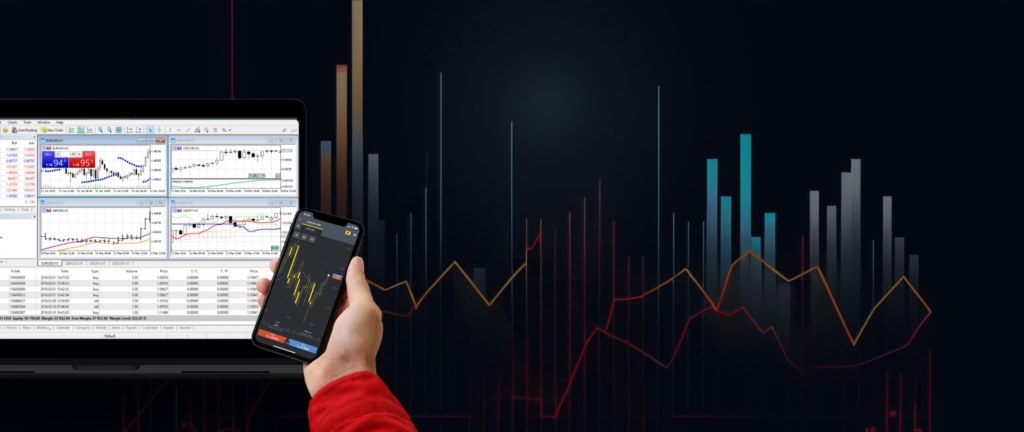
1. Accessibility
- Exness Web Terminals (MT4 & MT5): Both platforms offer seamless access via any web-enabled device, ensuring that traders can manage their accounts and execute trades without downloading additional software. This makes the platforms highly accessible and convenient for traders on the go.
- Other Platforms: While many trading platforms offer web-based versions, some lack the integration and ease of use found in Exness terminals, which could limit accessibility and trading experience.
2. Functionality
- Exness Web Terminals: Both MT4 and MT5 web terminals deliver the full functionality of their desktop counterparts, ensuring that traders can utilize all necessary tools for market analysis, order placement, and strategy execution, even from a browser.
- Other Platforms: Web versions of some trading platforms may be limited in functionality, restricting access to certain features or technical indicators that are available on the desktop version. This could limit the ability of traders to conduct in-depth analysis or manage trades effectively.
3. User Experience
- Exness Web Terminals: The platforms are designed with simplicity and efficiency in mind, making them easy to navigate for both beginners and experienced traders. The user-friendly interfaces allow for smooth operations, whether placing trades or conducting technical analysis.
- Other Platforms: User experience varies across platforms. Some offer a sleek and intuitive design similar to Exness, while others may be more complex or clunky, making them difficult to navigate, particularly for traders new to the markets.
4. Performance
- Exness Web Terminals: Optimized for smooth performance, the MT4 and MT5 web terminals are designed to minimize latency, though this largely depends on internet connectivity and browser performance. During high-volatility market periods, the platform generally maintains stability.
- Other Platforms: The performance of web-based platforms can vary widely. Some may experience lag or slower response times, especially during periods of significant market activity, which can be detrimental to traders who rely on quick execution.
MT4 vs. MT5: A Closer Look at the Differences
While both platforms are highly functional, there are key differences between the MT4 web terminal Exness and the MT5 web terminal Exness:
| Feature | MT4 Web Terminal | MT5 Web Terminal |
| Timeframes | 9 timeframes available | 21 timeframes, offering more flexibility |
| Order Types | 4 types of pending orders | 6 types of pending orders, including stop limits |
| Depth of Market | Not available | Available, allowing for a more detailed market view |
| Economic Calendar | Not available | Integrated directly into the platform |
| Technical Indicators | 30 built-in indicators | 38 built-in indicators for more advanced analysis |
| Assets | Forex, metals, indices, and energies | Forex, stocks, indices, futures, and cryptocurrencies |
Conclusion
The Exness MT4 and MT5 Web Terminals provide an excellent web-based trading experience, offering comprehensive functionality that rivals their desktop counterparts. Both platforms excel in accessibility, allowing traders to manage their accounts from any device with an internet connection, without sacrificing any of the tools needed for professional trading.
FAQ
What is the difference between the Exness MT4 and MT5 Web Terminals?
The Exness MT4 Web Terminal is ideal for traders who prefer simplicity, offering basic yet comprehensive trading tools. The MT5 Web Terminal, on the other hand, provides more advanced features, including additional timeframes, technical indicators, and support for more complex order types, as well as a wider range of assets like stocks and cryptocurrencies.

